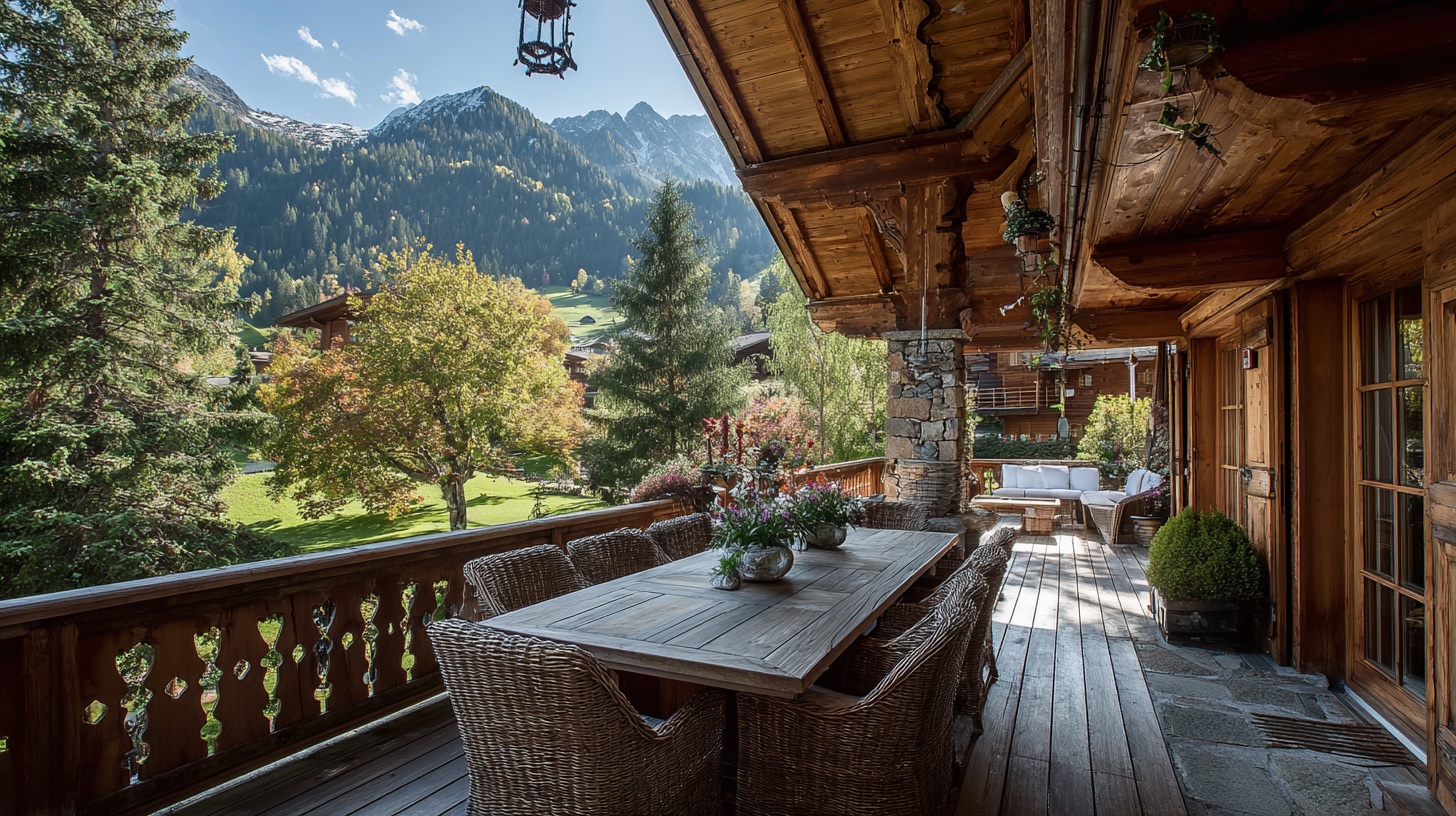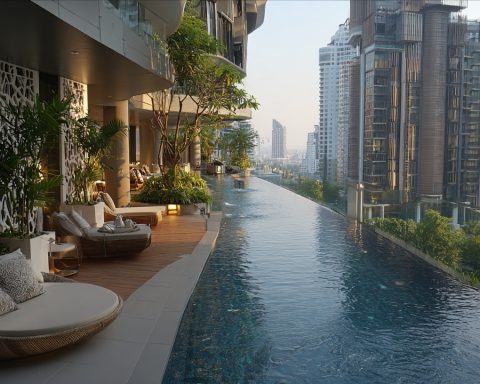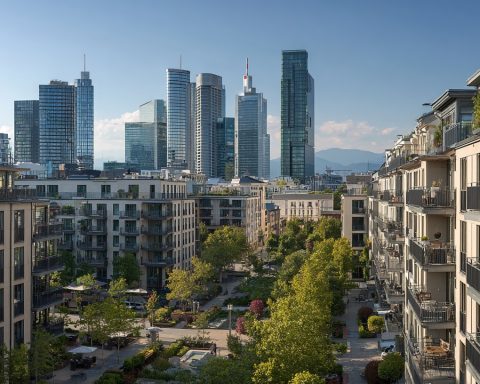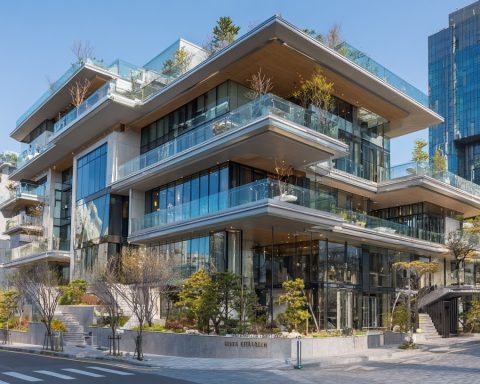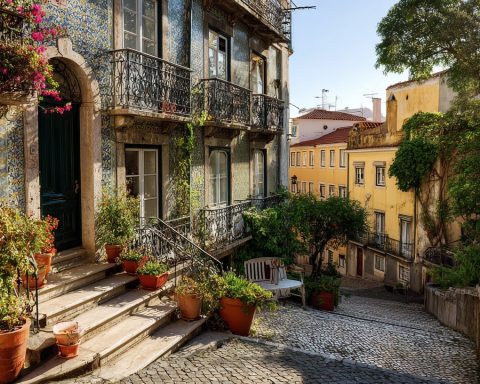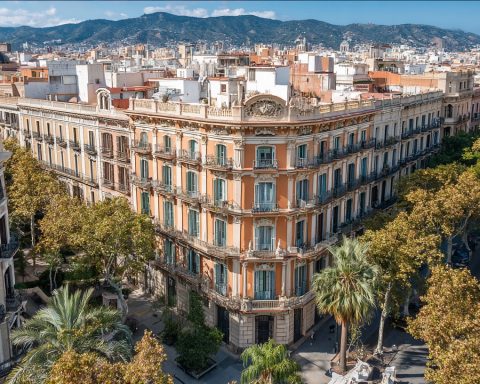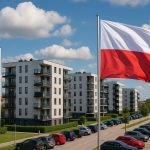Gstaad, a picturesque Swiss Alpine resort, has one of the world’s most exclusive and supply-constrained property markets. In 2025, its real estate prices are sky-high and still climbing, fueled by global wealth and the town’s perennial charm. Demand remains robust for Gstaad’s iconic chalets, even as economic headwinds temper growth in some markets. This comprehensive report examines Gstaad’s residential and commercial property prices, investment opportunities and risks, luxury chalet trends, rental yields, key market players, demand drivers, regulations, and long-term forecasts through 2030. All findings are based on recent data and expert analyses from Swiss real estate platforms, market reports, and luxury property agencies.
Current Residential and Commercial Property Prices in Gstaad
Residential Prices: Gstaad ranks at the pinnacle of Swiss real estate values. In 2024, prime residential properties averaged about €41,500 per square meter, reflecting ~4% annual growth knightfrank.com. According to UBS’s 2025 Luxury Property Focus, luxury chalets in Gstaad now start around CHF 39,000 per m² (≈€40,000), with ultra-prime homes easily exceeding CHF 50,000 per m² ubs.com. In exceptional cases, record-breaking prices above CHF 100,000 per m² have been observed for trophy estates ubs.com. For context, Gstaad’s prices rival or surpass other elite Alpine markets – St. Moritz (starting ~CHF 43,000/m²) and Verbier (~CHF 36,000/m²) trail closely behind ubs.com. This makes Gstaad one of the most expensive property markets in Europe, with average chalet values having risen roughly 27% since 2019 ubs.com ubs.com.
Commercial Prices: While detailed data on Gstaad’s commercial real estate (such as retail and hospitality properties) is limited, the market mirrors the high residential values. The village’s famed pedestrian promenade – lined with luxury boutiques, art galleries, and fine dining – commands top prices for retail space due to very scarce supply. Prime shop rents are known to be steep, sustained by consistent tourist foot traffic and ultra-high-net-worth clientele. Similarly, hotels and mixed-use chalets rarely trade publicly, but any available commercial properties in Gstaad are priced at a hefty premium. Overall, both residential and commercial real estate in Gstaad are characterized by limited inventory and intense demand, which underpin the extraordinary price levels.
Price Snapshot: Table 1 below summarizes approximate luxury property price levels in Gstaad versus other prime Swiss markets:
| Location | Luxury Price (CHF/m²) | Recent Annual Growth |
|---|---|---|
| Gstaad (Bern Alps) | ~39,000+ (starting price) ubs.com | +4% (2024) knightfrank.com |
| St. Moritz (Grisons) | ~43,000+ (highest in CH) ubs.com | +5.6% (2024) knightfrank.com |
| Verbier (Valais) | ~36,000+ ubs.com | +3–5% (est. 2024) |
| Geneva – Cologny | ~36,000 (lakefront) ubs.com | +2–3% (est. 2024) |
| Zurich – Küsnacht | ~32,000 (lakefront) ubs.com | +3% (est. 2024) |
Table 1: Ultra-prime property prices in Gstaad vs. other top Swiss locales. Gstaad’s CHF 39k/m² starting price for luxury homes is among the highest, second only to St. Moritz ubs.com. (CHF 1 ≈ EUR 1.0 in mid-2025.)
Gstaad’s average home prices far exceed national benchmarks. By comparison, the city of Bern’s apartments average ~CHF 11,450/m² globalpropertyguide.com, and even Zurich – Switzerland’s priciest city – averages ~CHF 21,000/m² for apartments globalpropertyguide.com (about half of Gstaad’s top-end rates). This underscores how extraordinary Gstaad’s valuations are, reflecting its global trophy status. With so few properties ever on the market (see Supply below), buyers often pay whatever it takes to secure a piece of Gstaad.
Projected Property Price Trends (2025–2028)
Near-Term Outlook: Industry forecasts project that Swiss property prices will continue rising in the mid-2020s, albeit at a more moderate pace than recent years. Wüest Partner (a leading Swiss real estate consultant) expects 2025 nationwide price growth around +3.6% for apartments and +3.8% for houses globalpropertyguide.com – a slowdown from 4–5% gains seen in 2024. UBS similarly foresees a 3–4% increase in 2025 for overall residential prices globalpropertyguide.com. In the luxury segment, price momentum has already cooled: in 2024, Swiss luxury home prices rose only ~1.2% on average, down from ~2%+ the year prior ubs.com. Gstaad’s high-end market mirrored this trend, decelerating to low-single-digit growth last year knightfrank.com. Market experts describe 2025 as another year of consolidation, with luxury home values likely levelling off or inching up only slightly (on the order of +1–3%) ubs.com. The consensus is that Gstaad’s prices have reached a temporary plateau at very high levels, as the pool of buyers able to pay these sums is naturally limited ubs.com.
However, no price corrections are expected in Gstaad absent a major external shock. The fundamentals (wealthy demand vs. scant supply) remain firmly supportive. A recent analysis forecasted Gstaad’s property prices to resume gentle growth by 2026, in the range of roughly +2.8% to +4.2% annually theluxuryplaybook.com. Growth may be led by the most coveted “trophy” chalets in neighborhoods like Oberbort and Bissen (Gstaad’s prime hilltop areas), where ultra-rich buyers compete for rare offerings theluxuryplaybook.com. Surrounding villages (Saanen, Rougemont, etc.) should see spillover demand, potentially outperforming Gstaad’s core in percentage growth as buyers seek relative bargains.
Long-Term (2025–2030): Over the later 2020s, Gstaad’s real estate is expected to maintain its value and likely appreciate further, but at a steady, modest clip. Forecasts through 2030 generally envision cumulative price growth in the 15–25% range (averaging perhaps +3% per year). This implies that by 2030, Gstaad’s top-tier prices could exceed CHF 50,000 per m² on average, barring new supply that significantly changes the balance. Several factors underpin this outlook:
- Global Wealth Growth: The continued creation of ultra-wealthy individuals (especially from tech and finance sectors) fuels demand for Alpine trophy homes investropa.com. Many UHNWIs (ultra-high-net-worth individuals) are drawn to Switzerland’s stability and prestige, suggesting a stable buyer base through 2030 investropa.com.
- Supply Constraints: Gstaad’s severe housing shortage will persist (see Supply & Development below). With buildable land tightly restricted by geography and law, new supply will trickle out slowly. Even a minor uptick in construction (due to a recent law change) only slightly eases the squeeze ubs.com ubs.com. Scarcity will keep prices resilient long-term investropa.com.
- Safe-Haven Appeal: Switzerland’s safe-haven status (strong franc, stable politics) is unlikely to diminish. In uncertain times, wealthy buyers park capital in Swiss real estate, supporting values even if global markets falter forbesglobalproperties.com forbesglobalproperties.com. Gstaad, being among the most exclusive markets, should particularly benefit from this “safe asset” appeal.
- Lifestyle & Climate Trends: Interestingly, climate change may boost Gstaad’s allure to certain buyers. As summers grow hotter elsewhere, cool Alpine locales like Gstaad and Verbier have seen upticks in wealthy buyers seeking refuge from extreme heat and weather brochures.christiesrealestate.com. By 2030, this “climate refuge” factor could further strengthen demand for Swiss mountain homes, according to Christie’s International Real Estate experts brochures.christiesrealestate.com.
In summary, barring major shocks, Gstaad’s real estate values are projected to trend upward through 2030, but at a measured pace. The era of double-digit annual price jumps is likely over; instead, think “slow climb” from an extremely elevated base. Even if annual gains average only 2–4%, Gstaad will remain a top-performing property market in absolute price terms. Owners can expect that their chalets will hold value or appreciate modestly, while new entrants will continue to face record-high entry prices in the years ahead.
Investment Opportunities and Risks in Gstaad
Opportunities: Despite eye-watering prices, Gstaad offers unique advantages to real estate investors – chiefly stability, exclusivity, and long-term wealth preservation. Key opportunities include:
- Safe-Haven Asset: Swiss alpine property has proven to be a rock-solid store of value. Even during global crises (financial crash, pandemic), Gstaad’s prices barely wavered and in fact are ~25% above pre-COVID levels as of 2023 investropa.com. Investors view Gstaad chalets as “real asset” hedges akin to fine art – insulated by limited supply and Switzerland’s safe-haven economy forbesglobalproperties.com forbesglobalproperties.com.
- Capital Appreciation: While rapid flips are rare, steady appreciation is a reasonable expectation. With demand outstripping supply, values should continue a gradual ascent (as noted, perhaps ~3% annually) globalpropertyguide.com. Over a holding period of 5–10 years, this can lead to substantial capital gains given the high base values.
- Rental Income & ROI in Peak Seasons: Owners who rent out their chalets during peak periods can earn significant income. Luxury weekly rents in Gstaad during ski season or summer festivals run very high (often tens of thousands of CHF per week for prime chalets). Strong tourism means occupancy is excellent in peak months – for example, in February 2024 local 5-star hotels ran at an 80–90% occupancy rate ubs.com, indicating robust lodging demand. With upscale hotel room rates up ~30% over five years ubs.com, private chalet rentals have similarly lucrative pricing power, boosting rental yields for owners. Gstaad’s short-term rental market thus offers a chance to offset ownership costs (more in the Rental section below).
- Portfolio Diversification: Owning a Gstaad property diversifies an investment portfolio into tangible real estate in a stable jurisdiction. For family offices and HNWIs, this diversification – outside of stocks or volatile markets – is very attractive, especially in uncertain economic times forbesglobalproperties.com.
- New Development/Value-Add: With the relaxation of certain building rules (see Lex Candinas under Regulations), there may be select opportunities for development or redevelopment. Building new homes in Gstaad was virtually frozen by law for years ubs.com. Now, some previously forbidden projects (e.g. converting hotels to apartments or enlarging older chalets) might proceed ubs.com. Developers or investors who can navigate local rules could find high-margin projects, as demand for any new high-end units is intense. Even small apartment developments or renovated farmhouses in the Saanenland can command premium prices once completed.
- Surrounding Areas: The broader Gstaad region (Saanen, Rougemont, Schönried) might present opportunities at slightly lower price points. International buyers who are priced out of central Gstaad often consider these nearby villages (just minutes away) where prices, while high, can be 20–40% less. As Gstaad’s core values push higher, properties on the periphery may see outsized appreciation as “affordable” alternatives for those determined to buy into the lifestyle.
Risks: Investors must also weigh notable risks and challenges in the Gstaad market:
- High Entry Cost & Low Yield: Gstaad’s astronomical prices mean initial yield on investment is very low. Gross rental yields in the region are typically in the 2–3% per year range or less globalpropertyguide.com globalpropertyguide.com, far below global property averages. The Canton of Bern (which includes Gstaad) has average apartment yields around just 2.8% globalpropertyguide.com. This is a “cash flow-light” investment; owners rely primarily on long-term appreciation for returns. If one finances the purchase, mortgage affordability tests can be strict due to the low yield coverage (Swiss banks assume high imputed interest rates in affordability calculations, which can disqualify all but the wealthiest cash buyers) ubs.com.
- Liquidity & Resale Risk: The pool of buyers for multi-million-franc chalets is inherently small. Selling a property can take time, as it may require waiting for the “right” billionaire to come along. If market conditions turn or new regulations hit (see below), liquidity could dry up and force price discounts to achieve a sale. Gstaad properties are often held for generations, and quick resale is not guaranteed.
- Regulatory Changes: Switzerland’s evolving laws pose perhaps the biggest risk to the luxury segment. In March 2025, the government announced plans to tighten the Lex Koller law, potentially banning or restricting foreign buyers from purchasing Swiss holiday homes ubs.com. If enacted, this would directly affect demand in places like Gstaad (which has many foreign buyers), likely dampening prices for secondary residences ubs.com. Additionally, tax reforms under discussion – such as eliminating the mortgage interest deduction and instituting a tax on second homes – would raise holding costs and could cool demand ubs.com. Investors face uncertainty in how these policies might play out (details under Regulations section). Regulatory risk is non-trivial, as Switzerland’s populace has shown support for curbing luxury home sales to outsiders in the past.
- Economic & Market Factors: A sharp downturn in global stock markets or a recession hitting the ultra-rich could reduce demand temporarily. Gstaad’s 2024 slowdown in price growth was partly because previous “price overshoots” left values so high that buyers grew cautious ubs.com ubs.com. Should interest rates unexpectedly spike or the Swiss franc strengthen further, some marginal buyers might delay purchases ubs.com. While a crash seems unlikely due to limited supply, flat or modestly declining prices for a period cannot be ruled out if economic conditions worsen.
- Climate and Seasonality: Ironically, while Gstaad might benefit from being a climate refuge, it also faces the risk of shorter ski seasons in the long run. At ~1,050m village elevation (with skiing up to ~3,000m on nearby glaciers), Gstaad is relatively low-altitude for a ski resort. If snow reliability were to decline significantly by 2030, it could impact winter tourism and the appeal of ski properties. The region is investing in year-round attractions (biking, culture, etc.), but a part of Gstaad’s cachet is tied to its winter wonderland image. Climate change is a long-term risk factor to monitor for any alpine real estate investment.
In summary, investing in Gstaad property is a play for capital preservation and prestige more than high yield. It offers rock-solid safety and upside potential over the long haul, but at the cost of high carry expenses and exposure to regulatory shifts. Careful due diligence on legal and tax changes, and a willingness to hold for many years, are prerequisites for success in this rarefied market.
Trends in Luxury Real Estate and Chalets in Gstaad
Gstaad’s luxury real estate market is defined by ultra-high-end chalets and a blend of tradition with modern comfort. Several key trends are shaping the luxury chalet scene in 2025:
- Rising Demand for “Year-Round” Alpine Living: Traditionally a winter haven for skiing, Gstaad now aggressively promotes itself as a year-round destination. Buyers today seek chalets that can be enjoyed in all seasons, not just for a few ski weeks. Many properties are being outfitted with four-season amenities – from indoor pools and spas (for winter coziness) to expansive summer terraces and gardens. The village hosts over 1,000 cultural and sporting events annually, including famous summer music festivals, tennis, polo, and equestrian tournaments john-taylor.com. This year-round vibrancy has increased demand for homes that serve as second residences throughout the year (with home offices, fast internet, etc.), rather than purely seasonal ski lodges.
- Blend of Alpine Charm and Modern Luxury: Today’s buyers covet “modern alpine” style – preserving the traditional chalet charm (aged wood beams, gabled roofs) but with fully modernized interiors and technology. Many classic chalets are being gut-renovated to feature contemporary open-plan layouts, high-end kitchens, home cinemas, climate control, and smart-home systems, all behind a rustic facade. There’s also a trend towards sustainable luxury: installing geothermal heating, solar panels, and energy-efficient materials, in line with Switzerland’s green building push. Luxury buyers increasingly expect eco-friendly features alongside their saunas and wine cellars. This aligns with the broader Swiss trend of rising interest in energy-efficient homes and sustainable building materials in 2024–25 investropa.com investropa.com.
- Mega-Chalets and Amenities: The definition of “chalet” in Gstaad keeps expanding – quite literally. Recent years have seen construction of a few mega-chalets (estates) that span 800–1,000 m² of living space, often combining two or more plots. These bespoke homes boast amenities like indoor pools, private wellness centers, gyms, staff quarters, underground garages, and even small nightclubs or art galleries. Privacy and on-site entertainment are paramount. At the same time, some buyers are opting for “right-sized” luxury: an emerging trend (especially among some European buyers) is interest in smaller, cozier high-end chalets that are easier to maintain. This dovetails with a mini-shift toward minimalism and efficiency – a reaction against oversized mansions investropa.com. Still, in Gstaad the pendulum largely swings toward opulence; big-spending international buyers frequently seek the largest, most lavish properties their money can buy.
- New Developments & Branded Residences: Given construction limits, entirely new developments are rare, but a few high-profile projects have made waves. Notably, the “Alpine resort residences” concept is growing: branded residences attached to luxury hotels (for instance, the Ultima Gstaad opened a few years ago blending a 5-star boutique hotel with private apartments serviced by the hotel). Such offerings appeal to those who want a home with concierge, security, and hotel amenities on call. Going forward, if regulations allow, Gstaad could see more creative development models – e.g. ultra-luxury apartment chalets or serviced condos – to maximize use of limited plots. Lex Candinas (2024’s legal change) might enable a handful of apartment projects marketed to foreigners as investment properties (similar to ski resort condos in other countries), though this will unfold slowly ubs.com. Investors should watch for any new construction announcements as they will be scarce and highly sought-after.
- Maintaining Authenticity: Despite the glitz, Gstaad’s appeal lies in its “alpine authenticity” married to luxury. The community fiercely protects its traditional character – strict architectural codes ensure chalets keep a classic look (no flashy modernist villas allowed). Even new builds must often use natural stone, timber, and conform to chalet aesthetics. This trend of conservation of style ensures the village never loses its storybook charm. Buyers appreciate that “Gstaad’s brand is stylish charm with discreet, understated luxury” and a strong alpine identity john-taylor.com. Notably, there are still 200 working farms and 7,000 cows in the Saanenland region john-taylor.com – a reminder that Gstaad remains a living farming community as well as a jet-set enclave. This genuine atmosphere is a huge selling point versus more commercialized resorts.
In essence, Gstaad’s luxury real estate trend is evolution without losing tradition. Chalets are becoming more sophisticated and equipped for modern living, but the village is careful to retain the cozy, idyllic ambiance that made it famous. Buyers in 2025 can expect a market where old-world charm meets new-world luxury – from century-old wooden farmhouses converted into designer holiday homes, to brand-new chalets built to look 200 years old but wired with cutting-edge tech. This combination continues to enchant the global elite and sustain Gstaad’s position at the pinnacle of alpine luxury.
Rental Yields and Short-Term Rental Market Trends
Gstaad’s rental market is unique: it caters largely to the short-term luxury vacation segment and to a lesser extent long-term locals (many of whom benefit from subsidized or cooperative housing). Key points on rental yields and trends:
- Low Yields on Capital Value: As noted, gross rental yields in Gstaad are low in percentage terms due to the extremely high property values. Average residential yields in Canton Bern are only about 2.8% annually globalpropertyguide.com, and in ultra-prime markets like Gstaad town, the true yield can be even lower (often 1–2% range for luxury chalets). For example, a chalet worth CHF 20 million might realistically fetch around CHF 200k–300k per year in rental income in a good year, which is ~1–1.5% yield. This is significantly below yields in many other investment destinations – Swiss property is generally a “capital play” rather than a yield play facebook.com. That said, rental demand is strong, so nearly all luxury owners who do rent out are able to find tenants at top rates; the limitation is mostly the high denominator (property price).
- Short-Term Rentals & Holiday Lets: The short-term rental market in Gstaad is vibrant and increasingly facilitated by both local agencies and platforms. Many owners choose to rent their chalets on a weekly basis during peak seasons (Christmas/New Year, February ski weeks, and July-August summer season). Rental rates for a top-tier chalet can easily exceed CHF 25,000–50,000 per week in peak winter, given the caliber of clientele. Even smaller apartments can command several thousand francs weekly when demand peaks. Occupancy is highly seasonal – properties might sit empty in shoulder seasons (muddy April, quiet November), but achieve near-full occupancy in high season. Overall, for an owner willing to rent out, seasonal short-term rentals can significantly offset annual costs (property taxes, maintenance, etc.), though few achieve full break-even purely via rent. The UBS Alpine report notes that with luxury hotel room prices up ~30% since 2019, renting out a holiday home has become more profitable than before ubs.com as travelers seek private space for families and groups. This trend is encouraging more owners to list their chalets for select weeks, often via specialized luxury rental agencies rather than mass-market sites.
- Rental Platform Trends: Airbnb and similar platforms have a presence in Gstaad but mainly for smaller apartments or lower-end chalets. High-end properties are typically handled by luxury brokers or concierge companies (for privacy and full-service expectations of renters). There is a growing trend of “managed chalets”, where companies take on a chalet, staff it with a chef and concierge, and rent it as an ultra-luxury vacation package. These can yield substantial income. The short-term rental sector in the Swiss Alps overall is seeing professionalization, with investors even eyeing dedicated rental chalets as a business model (though in Gstaad, buying purely to rent out is tough for foreigners due to permit rules – see Regulations).
- Long-Term Rentals: Long-term renting of luxury chalets in Gstaad (yearly leases) is relatively uncommon, as owners prefer flexibility and personal use. However, there is a modest expat community and seasonal workforce that rents apartments year-round. For instance, staff of international schools, luxury shops, or hotels may rent in the area. Vacancy rates are extremely low (<1% in Saanenland for apartments) given the housing shortage investropa.com. Rent controls in Switzerland keep annual rent increases modest for existing tenants, so landlords of long-term rentals face some regulatory constraints (e.g. tied to the reference interest rate). Most investors in Gstaad real estate are not targeting long-term rental yield; they either want a private vacation home or plan to do short-term lets selectively.
- Impact of Tourism Trends: With tourism to Switzerland rebounding strongly post-pandemic (2024 saw tourist nights up by high single digits), short-term rental demand is robust and rising. If Gstaad continues expanding its slate of events and activities, the rental season may lengthen (e.g. attracting more summer renters for hiking, mountain biking, festivals). An emerging micro-trend is “workcation” stays, where wealthy individuals or families rent a chalet for several months, blending remote work with holiday. Gstaad’s improved broadband and tranquil environment make it appealing for such extended stays. This could slightly boost off-peak occupancy and thus improve effective annual yields.
In summary, rental yields in Gstaad are modest on an investment basis, but landlords benefit from a very secure, high-demand rental environment. There is essentially zero risk of not finding renters when you want them, given the global allure of the location – the limiting factor is how often an owner is willing to rent out their prized chalet. Those who do capitalize on peak periods can earn healthy rental income, even if it’s a low percentage of the property’s massive value. For many owners, covering some costs and retaining flexibility for personal use is the main goal, rather than maximizing yield. Gstaad thus remains primarily a lifestyle investment rather than a high-yield rental market, though the short-term rental segment is growing and professionalizing alongside tourism growth.
Key Developers and Real Estate Agencies in Gstaad
Despite its small size, Gstaad is served by a number of specialized luxury real estate agencies and developers. These firms cater to the high-end market, offering brokerage, property management, and bespoke development services:
- John Taylor Gstaad: The local branch of the global luxury realty firm John Taylor is a major player. John Taylor Gstaad AG (based in Saanen) specializes in the sale and rental of high-end chalets and apartments in Gstaad and surrounding villages john-taylor.com. They handle many of the region’s marquee listings and also arrange seasonal rentals. John Taylor’s network and experience (over 160 years in luxury realty globally) make it a go-to for international buyers seeking discretion and expertise. Their Gstaad team emphasizes the area’s “prestige meets alpine authenticity” and has intimate knowledge of hidden gems in the Saanenland john-taylor.com.
- BARNES Gstaad: BARNES International Realty operates an office in Gstaad as well, focusing on high-end properties. Barnes provides brokerage for chalets, apartments, and land, and often publishes market insights. Their global reach (especially in Europe and the US) brings additional international buyers to Gstaad. The Barnes Gstaad team is known for curating an “exceptional listing of chalets and apartments” and tapping into its wealthy client base via glossy publications and events.
- Sotheby’s International Realty – Gstaad: The esteemed Sotheby’s brand has representation in the area through Switzerland Sotheby’s International Realty (often in partnership with local firm Cardis or others). This brokerage deals in ultra-prime Swiss properties and has marketed some of Gstaad’s most expensive estates to its global network of collectors and investors. Their presence ensures Gstaad’s top properties reach an international audience of UHNW individuals already familiar with the Sotheby’s brand.
- Engel & Völkers Saanenland: Engel & Völkers, the German-founded luxury agency, has a franchise covering the Gstaad/Saanen region. They provide sales and rental services and are known for their strong marketing and cross-border client reach (especially in German-speaking markets). E&V often produces regional market reports and has an office easily accessible to walk-in clients in the village. They cater to both Swiss and foreign buyers looking for resort real estate.
- Local Developers (NK Immobilien / GRIWA Group): On the development side, nk Immobilien Gstaad (founded in 2015 by a local entrepreneur) has grown into a notable real estate service firm nkimmobilien-gstaad.ch. Now part of the GRIWA Treuhand group, they develop and build chalets and apartments in the Bernese Oberland, including the Saanenland region nkimmobilien-gstaad.ch. NK/GRIWA handle everything from design and construction to sales and rentals, often providing turnkey solutions. They focus on high-quality local architecture that meets strict alpine style guidelines. Such local developers, though small in number, are crucial for creating new housing stock (within legal limits) and renovating older properties. Another example is CGI Real Estate and Steiner AG, firms that occasionally undertake larger projects like hotel redevelopments or apartment complexes in alpine resorts (though in Gstaad these are rare).
- Other Agencies: Additional boutique agencies include Michaël Zingraf Real Estate (Gstaad) – a recent entrant associated with Christie’s International Real Estate, focusing on luxury chalets – and Comptoir Immobilier (a Geneva-based firm that’s part of Forbes Global Properties, sometimes handling Gstaad area deals). Gstaad Properties and Saanen Properties are local outfits offering personalized brokerage services by long-time residents with deep networks. The Gstaad Property Office (GPO) and Luxury Places are other consultants known in the region. A number of these agencies collaborate; for example, an exclusive listing might be shared co-operatively among a few trusted agents to find the right buyer.
These agencies not only facilitate transactions but often act as gatekeepers to a very discreet market – many Gstaad sales happen off-market, with agencies quietly matching sellers and buyers. Real estate marketing in Gstaad is low-key; you won’t see many “For Sale” signs. Instead, agencies maintain waiting lists of clients and do targeted outreach when a suitable property becomes available. The key players have deep ties to wealth managers, family offices, and existing homeowners (who often approach them first when considering selling). This network-driven dynamic means selecting a reputable, well-connected agency is crucial for any newcomer hoping to buy in Gstaad’s tight market.
In summary, key real estate professionals in Gstaad include a mix of international luxury brands (John Taylor, Sotheby’s, Barnes, E&V) and a few local experts who handle development and niche deals. All operate within a small, collegial community to maintain Gstaad’s reputation for discretion and quality. Buyers and sellers typically engage one of these firms to navigate the complex regulatory environment and to tap into the ultra-high-end client base that defines Gstaad’s property scene.
Market Demand Drivers in Gstaad
Several strong demand drivers underpin Gstaad’s real estate market, explaining why this tiny alpine village attracts intense interest from wealthy buyers worldwide:
- Elite Tourism and Lifestyle: Gstaad has long been a magnet for the rich and famous, offering an appealing mix of luxury and rustic charm. The town’s slogan “Come up, slow down” captures its relaxed exclusivity. It boasts five-star hotels, gourmet restaurants, designer boutiques, and art galleries lining a charming car-free promenade john-taylor.com. At the same time, working farms and historic alpine culture give it authenticity. This blend draws high-end tourists year-round. Many visitors – enamored by Gstaad’s ambience – become property buyers to secure their own alpine retreat. The sheer volume of events (1,000+ per year), from the Snow Polo tournament and Swiss Open tennis to the Menuhin classical music festival, ensures Gstaad stays on the global radar john-taylor.com. Such international events bring in affluent spectators, some of whom purchase holiday homes after falling in love with the area. In short, Gstaad’s lifestyle offering is a key demand driver – few places on Earth allow one to ski in the morning, attend a gala or concert at night, and stroll a village that hasn’t lost its storybook feel.
- International Buyers and “Brand Gstaad”: Gstaad’s property market is overwhelmingly driven by international buyers. Wealthy individuals from the UK, Germany, France, Belgium, the Middle East, the US, and increasingly Asia have been active here for decades. The town’s global profile is boosted by high-profile part-time residents and fans (royalty, celebrities, magnates), lending it a certain cachet. According to local brokers, “the Gstaad brand…attracts an international clientele all year round,” thanks to good transport links (2 hours from Geneva, 1 hour from Bern, and even a private airport in Saanen for private jets) john-taylor.com. This easy access means international owners can conveniently reach their chalets for holidays. Political and economic instability abroad also drives foreigners to safe Switzerland: in times of uncertainty, wealthy families from places like the Middle East or South America often increase property purchases in Switzerland for stability. Gstaad, being discreet and less “flashy” than St. Moritz or Courchevel, particularly appeals to those seeking privacy and understatement. The recent trend of global wealth migration (rich people relocating to safer locales) has benefitted Swiss resorts – Christie’s notes that extreme climate events elsewhere and geopolitical issues are prompting more wealthy buyers to pick alpine refuges like Gstaad for security brochures.christiesrealestate.com.
- Infrastructure and Connectivity: While a small village, Gstaad has invested considerably in infrastructure that enhances its appeal. The region’s ski lift system (Gstaad Mountain Rides) offers access to 200 km of ski pistes, and nearby Glacier 3000 ensures year-round skiing just 20 minutes away john-taylor.com. The panoramic Montreux–Zweisimmen train line passes through Gstaad, providing scenic rail connectivity to Montreux and beyond john-taylor.com. The Saanen private airport handles private jets and charters, a major plus for jetset owners john-taylor.com. Meanwhile, Switzerland’s road and rail network make Gstaad reachable (albeit with some effort) from major cities. Continued improvements – like faster train services, road tunnel upgrades, and high-speed telecom networks – support property demand. Additionally, infrastructure investment in ski resorts has been a national focus: e.g., nearby cantons invested in better lifts and public transport (Verbier’s public transport saw a CHF 27 million upgrade forbesglobalproperties.com). Gstaad has also modernized its hospitality and medical facilities to serve a demanding clientele. In essence, buyers know that despite Gstaad’s remote feel, it offers first-class infrastructure and access, which sustains long-term value.
- Economic and Tax Environment: Switzerland’s overall economic stability and pro-wealth environment strongly drive demand. The country boasts low inflation (~1% in 2024) and steady growth investropa.com. Crucially, Switzerland (and Canton Bern) offer a favorable tax regime for many wealthy foreigners, such as lump-sum taxation (“forfait”) agreements in some cases. While Bern’s taxes are higher than ultra-low-tax cantons like Schwyz, the Saanen/Gstaad area has still attracted some high-net-worth residents under special tax statuses historically. Moreover, no capital gains tax on property sales after a certain holding period (depending on canton) can benefit investors. There are also no annual property taxes in many parts of Switzerland (some communes have minor land taxes, but nothing like wealth taxes elsewhere). This relative tax friendliness and legal stability (strong property rights, banking privacy, etc.) makes owning Swiss real estate attractive. According to Forbes Global Properties, the combination of strict regulations (which limit supply) and a strong currency helped Swiss luxury property thrive even during the pandemic forbesglobalproperties.com forbesglobalproperties.com. Investors feel confident that their money in Gstaad real estate is protected by one of the world’s soundest legal and financial systems.
- Local Demand and Demographics: While international buyers dominate the top end, one should not ignore domestic Swiss demand. The pandemic saw more Swiss residents discovering or re-discovering local resorts, boosting second-home demand domestically. Also, the “Baby Boomer” retirement wave is a factor: affluent Swiss and Europeans in their 60s are retiring with substantial capital and a desire for leisure homes ubs.com ubs.com. Gstaad, with its gentle climate and year-round offerings, is appealing for active retirees. The Alpine cantons actually saw above-average population growth in 2024 (+0.9%) due to lifestyle relocation ubs.com. This indicates Swiss professionals and retirees moving to mountain areas for primary or secondary residences, adding to demand. Gstaad and Saanen’s full-time population has grown modestly, which pressures housing stock at all levels.
In summary, market demand in Gstaad is driven by its unparalleled lifestyle and reputation, easy access for a global elite, and the hard economic logic of investing in a secure, supply-constrained Swiss asset. As long as Gstaad continues to offer peace, prestige, and world-class amenities in a stable country, demand from both foreign and domestic high-net-worth buyers should remain strong.
Regulatory and Tax Considerations for Buyers
Switzerland has a complex web of regulations and taxes affecting real estate, especially for foreign buyers and vacation homes. Key considerations in Gstaad include:
- Lex Koller (Foreign Buyer Restrictions): The Swiss federal law “Lex Koller” limits property purchases by non-resident foreigners. In general, non-residents cannot buy residential property in Switzerland except in designated holiday zones under strict quotas. Gstaad (Commune of Saanen) is one such zone where foreigners have historically been allowed to buy a holiday home, but with conditions (e.g. plot size under 1,000 m² and living area under 200 m², one property per foreign family) forbesglobalproperties.com. Even those who qualify (typically EU residents or those with Swiss residency permits) often need cantonal approval. Important: In 2025, the Swiss government is considering tightening Lex Koller further ubs.com. Proposed measures could ban foreigners from buying certain types of properties (like apartments in serviced “aparthotels” or possibly any new second homes) ubs.com. If enacted, this would shrink the foreign buyer pool. Currently, foreign buyers already face annual permit quotas in Bern canton – once the small allotment of foreign-buy permits is exhausted, others must wait. Domestic buyers and Swiss permit holders (B or C permits) are not subject to Lex Koller, so they have an advantage in freedom to buy forbesglobalproperties.com forbesglobalproperties.com. Anyone considering purchasing in Gstaad needs to verify their eligibility under Lex Koller and stay abreast of any changes. Using a Swiss legal entity to bypass Lex Koller is prohibited (the authorities guard against shell company purchases) forbesglobalproperties.com.
- Lex Weber (Second Homes Law): Another critical law is the “Lex Weber” or Second Homes Initiative, passed in 2012, which caps second homes at 20% of housing stock per commune. Gstaad/Saanen was well above this limit, meaning since 2013 virtually no new holiday homes could be built – a major factor in the constrained supply ubs.com. Primary residence construction was still allowed, but these often can’t be sold as second homes later. In late 2024, a modification nicknamed “Lex Candinas” took effect, slightly easing the restriction ubs.com. It allows certain exceptions, like converting old hotels to residences or building in certain zones, to boost housing supply in tourist areas where it’s acutely tight (specifically naming Gstaad among others) ubs.com. This could result in a limited number of new apartments or chalets coming to market in future years, but likely still with resale/use restrictions. Bottom line: Lex Weber will continue to heavily constrain new supply in Gstaad – great for existing owners, challenging for new buyers. Prospective buyers can’t simply develop land freely even if they buy a plot; usage will be regulated (e.g., must maintain it as a primary residence or an agricultural usage if applicable).
- Taxes – Federal, Cantonal, Communal: Switzerland’s tax system has multiple layers. Relevant taxes for property buyers include:
- Property Transfer Tax/Stamp Duty: Canton Bern charges a property transfer tax (around 1.8% of purchase price, typically split between parties or paid by buyer – this can vary). Additionally, notary and land registry fees total ~0.3–0.5%. This adds roughly 2.3% transaction cost for a buyer in Gstaad.
- Annual Property Taxes: There is no recurring federal property tax. Canton Bern does levy a modest cantonal wealth tax, which includes real estate value (for Swiss residents only; ranges ~0.3–0.7% of net assets, with big exemptions). Non-resident owners typically won’t pay wealth tax unless they have Swiss residency. Some communes levy a small land tax; Saanen’s annual land tax is relatively low (in the few hundreds of francs for a luxury chalet).
- Imputed Rental Value Tax: Unusual to many foreigners, Switzerland taxes owner-occupiers on a fictional “rental income” from their home, roughly 70% of market rent. Owners can deduct mortgage interest and maintenance from this. Many second-home owners take mortgages partly to reduce this imputed rent tax. However, there’s a current proposal to abolish the imputed rental value nationwide, which would also remove the mortgage interest deduction ubs.com. If this reform passes, wealthy cash buyers benefit (no tax on imputed rent), but those who used debt lose a deduction.
- Capital Gains Tax: Canton Bern imposes a real estate gains tax on the seller’s profit if a property is resold within a certain time (on a sliding scale). Long-term holders (ownership over ~10 years) get favorable rates, and after a few decades the tax can drop to zero. This is meant to discourage speculation. Most Gstaad owners hold long-term, so this isn’t a frequent factor, but if you sell within e.g. 5 years for a profit, expect a significant CGT (could be 30%+ on the gain if very short-term).
- Rental Income Tax: If renting out the property, rental income is subject to Swiss income tax for Swiss residents (and for non-residents, potentially subject to a withholding tax). High-end owners often structure usage so that rental income is minimal or offset by expenses, to avoid tax complexities.
- Residency and Citizenship: Buying property in Gstaad does not automatically grant residency rights. Foreigners often need a residency permit first if they want to live full-time in their chalet. However, Switzerland does issue residence permits to wealthy individuals in some cases (who pay canton-negotiated lump-sum taxes). Canton Bern has offered such lump-sum arrangements to attract wealthy residents, though it’s less common than in some French-speaking cantons. Some foreign buyers choose to become residents of Switzerland (using business investor visas, etc.) to bypass Lex Koller entirely and enjoy Swiss living – in which case they then can buy property more freely. Buyers from the EU/EFTA with a Swiss B permit can purchase a home for their own use relatively easily forbesglobalproperties.com.
- Future Regulatory Watchpoints: In addition to Lex Koller tightening, there’s talk at the federal level of introducing a special tax on second homes (to discourage so many dark holiday homes in tourist areas) ubs.com. If a “second home tax” were implemented, owning a Gstaad vacation chalet could become pricier annually. Also, local authorities might impose rules such as rental restrictions (some resorts require registering short-term rentals or paying tourist taxes per rental night). Currently, Gstaad is quite laissez-faire compared to places like Zurich or Geneva which have strict tenant protections and rental caps – but this could change if locals feel squeezed by too many empty holiday homes. One more consideration: currency fluctuations (CHF vs home currency) can impact foreign buyers’ effective costs, but that’s a market risk rather than policy.
Conclusion (Regulatory): For domestic Swiss buyers, Gstaad’s rules mainly mean it’s hard to build new and one must pay transfer taxes and possibly gains taxes. For foreign buyers, careful navigation of Lex Koller and permit limits is essential – typically requiring patience or creative planning (e.g. buying in spouse’s name who has EU passport with a permit, etc.). It’s highly recommended to engage a Swiss notary and legal advisor early in the process. The regulatory climate overall has been one of restricting excessive investment (to protect Swiss housing affordability), which paradoxically has made Gstaad even more exclusive. Staying informed on upcoming votes or laws (like the Lex Koller revision) is key, as these could impact one’s ability to buy or sell to international buyers down the line ubs.com. Nonetheless, Switzerland’s stable rule of law means no sudden arbitrary changes – any new restrictions tend to be phased in, giving the market time to adjust. This stability and predictability itself is a hallmark that gives foreign investors confidence despite the layers of bureaucracy.
Long-Term Growth Forecasts Through 2030
Looking ahead to the end of the decade, experts remain cautiously optimistic about Gstaad’s real estate trajectory. Here are the long-term forecasts and factors shaping expectations to 2030:
- Price Growth Forecast: As discussed, baseline forecasts call for continued moderate price growth in Swiss residential real estate – on the order of 2–4% per year nationally globalpropertyguide.com. Prime resort markets like Gstaad could track the higher end of that range in good economic conditions (or slightly underperform if regulations bite). Over 2025–2030, that implies roughly +15–20% cumulative price increase in Gstaad’s luxury segment (e.g., an CHF 10 million chalet might average CHF 11.5–12 million by 2030). This is not a formal guarantee, but rather an extrapolation of current drivers: limited supply, steady demand, and Switzerland’s low interest-rate environment. UBS analysts note that stretched affordability will likely cap major price spikes, but a stable economy and scarce supply “will further support people’s willingness to pay up” for home ownership globalpropertyguide.com. In plain terms: don’t expect another doubling of prices this decade, but gradual appreciation is the prevailing outlook.
- Market Cycles and Resilience: Historically, Swiss alpine property has shown strong resilience. Knight Frank research finds alpine home values had an average annual growth of ~1.9% over 2009–2022, accelerating to ~4% annually post-2020 knightfrank.com. Even when challenged (e.g., by a strong franc or global crises), Gstaad’s prices tended to hold firm or dip only marginally. This pattern is expected to continue. Any future global recession might pause growth for a year or two, but a sharp decline in Gstaad values is seen as unlikely absent forced selling. The ultra-rich owners are typically not highly leveraged, reducing risk of distressed sales. Thus, the 2030 outlook is stable-to-positive, with Gstaad remaining a high plateau of pricing with incremental climbs.
- Demand Evolution: By 2030, the buyer demographic may evolve. We anticipate more younger wealthy buyers (in their 40s and 50s) entering the Gstaad market, particularly entrepreneurs from tech and emerging economies who are increasingly part of the UHNWI class investropa.com. These younger buyers may bring different tastes (more contemporary design, more emphasis on sustainability and wellness features). The market will adapt by offering smart-home integrations, EV charging in chalets, private wellness spas, etc., to meet these expectations. Also, if remote/hybrid work persists, more owners might spend extended periods in Gstaad, effectively using it as a primary home part of the year. This could marginally increase effective demand (people owning one big home instead of splitting into two smaller ones for different seasons, for example).
- Supply Outlook: On the supply side, no major housing glut is on the horizon for Gstaad. Even with Lex Candinas reform, the pipeline of new builds will remain thin – perhaps a handful of chalets or a small apartment block here or there. Indeed, UBS predicts new construction in alpine areas will stay well below national average rates ubs.com. If anything, by 2030 some existing chalets will be subdivided or redeveloped to house multiple units (especially if local authorities push to create housing for locals/hotel staff). But given heritage and aesthetic considerations, large-scale development is improbable. Therefore, by 2030 the total housing stock might increase only very slightly, underscoring a persistent supply pinch.
- External Risks and Wildcards: A few wildcards could sway the forecast. If Switzerland enacts a total ban on non-resident buyers in coming years (an extreme Lex Koller scenario), demand could shift to almost entirely resident-driven, which might soften prices at the margins. Conversely, if global geopolitical or climate issues intensify, Switzerland could see a surge of capital inflows as a safe haven, boosting luxury property beyond forecast. Macro-economic factors like interest rates are crucial too: the current forecast assumes rates stay relatively low or normalized. A return to very high interest rates by 2030 could cool even the luxury market (mostly by reducing Swiss domestic buyers’ capacity and making mortgages unattractive). Currency swings (a much stronger franc) could also make Swiss property pricier for foreign investors, possibly dampening overseas interest slightly ubs.com. These factors are hard to predict, but are worth monitoring.
- 2030 Vision – Gstaad’s Status: By 2030, Gstaad will likely remain what it is today: a crown jewel of alpine luxury real estate. It will continue to be listed among the world’s costliest property markets. We might see Andermatt or others rising in the ranks (Andermatt, for instance, has grown and was recently counted among the top five most expensive Swiss resorts after significant price gains forbes.com), but Gstaad’s established reputation and ultra-exclusive existing stock give it an enduring edge. The town’s efforts to remain attractive – expanding offerings for families, investing in sustainable tourism, keeping the village authentic – will help maintain demand.
In sum, the long-term forecast through 2030 for Gstaad real estate is steady growth and stability, with no indications of a bubble burst. Industry analysts essentially see a continuation of the current trend: mild price increases, occasional plateaus, but overall a high floor for values supported by global wealth trends and local scarcity. For investors and owners, Gstaad should continue to deliver on its promise of security and prestige in real estate. As one market report succinctly put it, “We assume prices for owner-occupied homes will rise in the medium term… limited supply will further support willingness to pay, but stretched affordability should limit any major increases.” globalpropertyguide.com – a scenario that perfectly encapsulates Gstaad’s likely path to 2030.
Sources:
- UBS Chief Investment Office, Luxury Property Focus 2025 (May 15, 2025) – Swiss luxury real estate trends and price levels ubs.com ubs.com.
- Knight Frank, Alpine Property Report 2025 (Nov 2024) – Prime ski resort prices and annual changes (Gstaad vs peers) knightfrank.com.
- Neho Real Estate, Gstaad Property Prices June 2025 – Local price change data (26.6% YoY increase, flats +16.6%).
- Global Property Guide, Switzerland Residential Market Analysis 2025 (June 2025) – Nationwide price indices, Wüest Partner forecasts globalpropertyguide.com globalpropertyguide.com.
- Forbes Global Properties, 5 Reasons Behind Switzerland’s Resilient Luxury Property Market (2022) – Gstaad ultra-prime prices (CHF 33k/m² in 2022) and market factors forbesglobalproperties.com forbesglobalproperties.com.
- Investropa, 16 Strong Trends for Switzerland’s Property Market 2025 – Luxury segment demand drivers, +25% vs pre-COVID pricing investropa.com investropa.com.
- John Taylor Gstaad Agency – Local market insight on Gstaad’s clientele, lifestyle, and connectivity john-taylor.com john-taylor.com.
- Christie’s International Real Estate, 2025 Global Luxury Real Estate Forecast – Noted climate-driven interest in Alpine regions brochures.christiesrealestate.com.
- Global Property Guide, Rental Yields in Switzerland Q2 2025 – Average rental yields by canton (Bern ~2.8%) globalpropertyguide.com.
- UBS Alpine Property Focus 2025 – Holiday home demand factors, supply shortage and new Lex Candinas law ubs.com ubs.com; regulatory risks like Lex Koller tightening ubs.com ubs.com.
- Julius Baer, Property Market Switzerland Q2 2025 – General market environment (interest rates cuts, demand momentum).
- Engel & Völkers, Residential Market Report Switzerland 2025 – Second-home market trends and regional outlooks.
